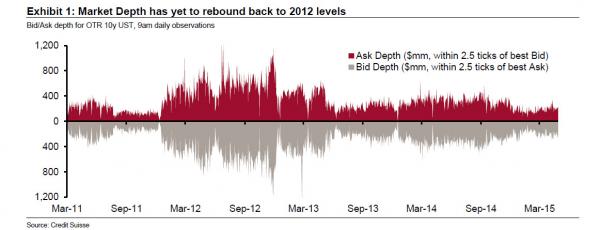
While we completely disagree with Credit Suisse about the reasons for the total collapse in bond market liquidity (as readers know we blame the Fed – as does the TBAC – and HFTs, while Credit Suisse accuses regulations, even though banks now hold a record amount of fungible bonds implying that unless bank prop desks can trade as FDIC-backstopped hedge funds once again it is simply impossible to have a stable, liquid bond market which is idiotic), we agree about one thing – the same thing we warned many years ago would happen: the total evaporation of liquidity in what was once the world’s deepest, most liquid market.
Case in point:

Remember, in any market and certainly bonds, volume is not liquidity or depth. Some more thoughts from Credit Suisse:
Shallower depth at times of higher volatility is at once a symptom and a source of the extreme price moves. Historically, market depth – which we measure as the aggregate bid and ask size for the on-the-run 10y note within 2.5 ticks of best on the other side – has ebbed and flowed with volatility. Surges in volatility typically cause depth to dissipate, whereas stable markets tend to be deeper.
While the core of this inverse depth/volatility relationship has remained in place, the last two years seem to have witnessed somewhat of a break, coinciding more or less with 2013’s taper tantrum. While delivered vol moderated in the aftermath of the mid-2013 selloff, depth has failed to return and at this point appears to have been structurally reduced. Early indications are that this has only become worse in the months since the October 15 “flash rally.” The only period that saw comparably low depth persist over the last four years was amid 2011’s debt ceiling and ratings downgrade in the US and the eurozone crisis (Exhibit 4).

One might be tempted to be long volatility to protect against the possibility for extreme price moves as market depth remains challenged. The risk of doing so is that one will bleed carry, however, as we have seen that there may be long periods of relatively stable markets interrupted by unexpected dramatic moves during extreme illiquidity.
















